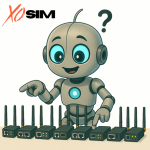
Cellular Gateways are getting eSIM enabled, Simplex works with all of them!
July 29, 2025
Global IoT Connectivity: What You Need to Know Before Deploying Worldwide
August 11, 2025How to Implement eSIM for IoT Devices Without Changing Hardware or Software
One of the biggest hurdles IoT companies face when adopting eSIM technology is the assumption that they need to rewrite firmware or redesign hardware. But what if you could implement eSIM on your existing devices—without any software changes at all?
That’s exactly what Simplex Wireless enables with our SGP.32-based eSIM solution—built around IPAe, the IoT Profile Assistant embedded in the SIM card itself. It’s a game-changer for IoT deployments that need remote profile management but can’t afford firmware revisions, development cycles, or testing delays.
The Problem with IPAd (Device-Based Profile Management)
The GSMA SGP.32 specification offers two profile management models for IoT eSIMs:
- IPAd: The IoT Profile Assistant runs on the device (the host).
- IPAe: The IoT Profile Assistant runs on the SIM card (eUICC).
While IPAd gives the host device control over eSIM provisioning, it requires custom software to be installed and maintained on the device. This creates friction for:
- Legacy hardware with limited memory or unsupported OS
- Fleet-wide firmware updates requiring time and validation
- Device makers who don’t want to maintain a connectivity stack
- Projects that can’t afford to re-certify their hardware
In short, IPAd increases cost, complexity, and deployment risk.
The Simplicity of IPAe: No Software Changes Needed
With IPAe, all logic required to manage eSIM profiles is embedded in the SIM card itself—meaning:
- No new software needs to be installed on your device
- No firmware updates are required
- You can implement eSIM immediately, even on devices already in the field
At Simplex Wireless, our eUICC SIMs are equipped with IPAe by default and fully compliant with the SGP.32 specification. These SIMs can initiate and manage profile downloads on their own, as long as the device supports a single, lightweight capability: Bearer Independent Protocol (BIP).
Tested on Hundreds of Devices—It Just Works
We’ve tested IPAe-based eSIM provisioning on hundreds of commercial IoT devices across categories like GPS trackers, routers, sensors, and industrial controllers.
All tested devices have supported IPAe. The only requirement has been that the device supports BIP. Most modems have BIP enabled by default.
In rare cases where BIP isn’t enabled out of the box, it can be easily turned on using standard AT commands.
See our guide here for step-by-step instructions:
How to Enable BIP/STK on Modems for eSIM SGP.32 Deployments
No SDKs. No client software. No firmware development cycles. Just plug in the SIM and go.
Real-World Applications Without Firmware Headaches
If you’re managing an IoT fleet deployed across cities, states, or continents, you can:
- Switch carriers remotely without touching the device
- Bootstrap new devices with a Simplex profile, then assign regional profiles OTA
- Enable local profile fallback for global deployments
- Avoid costly truck rolls or site visits just to update SIM configurations
Whether your devices are installed in EV chargers, smart meters, or GPS tracking units, Simplex Wireless helps you roll out eSIM with zero impact on your existing software architecture.
Why Simplex Wireless Is Different
- IPAe-first eSIM implementation
- In-house EIM platform built from the ground up in Atlanta, Georgia
- No reliance on MNOs or EUMs
- Carrier-grade reliability with disruptive pricing
- No hidden fees — see our transparent pricing
- Multi-network coverage across AT&T, T-Mobile, and Verizon in the USA
Simplex is the only independent provider with full-stack control of eSIM provisioning—from the card to the cloud.
Final Thoughts
You don’t need to wait for a hardware refresh or firmware sprint to roll out eSIM across your IoT deployment. With Simplex Wireless and SGP.32 + IPAe, you can activate remote SIM management on existing devices with minimal effort.
Ready to implement eSIM without touching your firmware?
Talk to our team or order a trial SIM and experience the power of plug-and-play eSIM for IoT.






